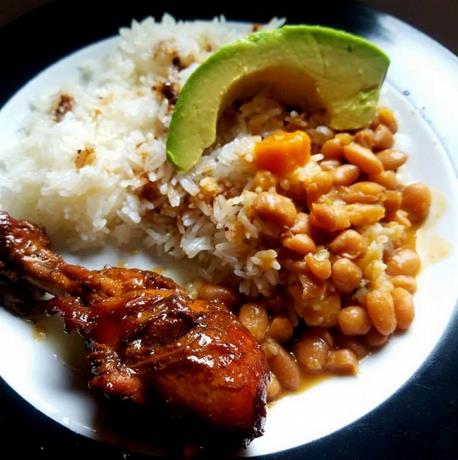Consuming the Bandera Domincana (“Dominican flag”) means RD$500 in a single day

High food prices affect family consumption.
Santo Domingo, DR.
For a Dominican family composed of five members to enjoy one of the country’s most consumed dishes, the Bandera Dominicana (the Dominican Flag), they must have a considerable budget in a scenario of unbalanced price increases worldwide.
As simple as it may seem, preparing a dish with white rice, chicken, and stewed beans, each with its seasonings and condiments, is an investment today that perhaps in the past would correspond to the preparation of a special delicacy.
However, satisfying this craving to eat “the Flag” becomes abnormally expensive with the increased price of products such as rice, meats, oil, red onion, and garlic. Therefore, in a consultation made by the Listín Diario in different grocery stores of the National District, specifically in the sectors Miraflores, Simón Bolívar, Capotillo, and Cristo Rey, the price of various articles to make this Creole meal was verified.
The managers of these establishments agreed on a simple, straightforward, and ready-to-at-once “send the delivery” to homes with two pounds of chicken at RD $200, likewise, with a two-pound package of rice costing RD $90 and a can of red beans at RD$95. They suggested that in the case of preferring the “Bandera” with beef, the pound of beef would cost RD$150.
In the hypothetical case that the person cooking this dish runs out of gas, they will have to find an extra RD$147.60 to buy a gallon at a Liquefied Petroleum Gas (LPG) station.
With this data and adding the pounds of chicken, rice, beans, and gas, the total is RD$532.
It is worth mentioning that the cost of preparing the Bandera will increase a little more about the price already established when taking into account what would be the seasoning of the beans and chicken, such as the onion is up to RD$50, the garlic at RD$59, as well as the cubanela chili at RD$32 and the bell pepper at RD$50.
To the plate of the Dominican flag, one could add a green plantain to make some tostones in the Creole style, whose price of the unit oscillates between RD$15 and RD$19, many times even regardless of the size, at the same time that one must consider the cost of the oil that is around RD$130.
However, if this same mother cooks this dish for 30 days, the cost would amount to RD$15,000 per month, representing almost two-thirds of the family basket of the first quintile of the population, that is to say, of the lowest social class.
The cost of the family basket in this distribution is RD $25,078.36 as of July 2022, according to figures from the Central Bank of the Dominican Republic (BCRD).
The national average of the five quintiles for the current year amounts to RD $42,269.58. On the other hand, for 2021, it was RD $40,074.16, RD 36,936.17, and 34,992.80 for the years 2020 and 2019, respectively.
Complaints about increases continue.
Although, in past months, the government authorities specializing in the economy have assured that food prices are stable, a part of the population continues to be alarmed by the increases that persist in the different articles of consumption. While it is true that the different streets of the city are full of “guagüitas” loaded with groceries, fruits, and vegetables at an apparently lower cost, the uneasiness persists on the part of the working class.
Social networks such as Facebook, Instagram, Twitter, and even the grocery stores and supermarkets themselves have served as a stage for citizens to vent about this issue, which has become a topic of national interest in the post-pandemic period.
In grocery stores in Santo Domingo East, a pound of rice from a recognized brand is worth RD$45 per pound, a pound of hot chicken is worth RD$80, and a pound of beans is worth RD$65. Likewise, an egg costs RD$7 and RD$8 per unit.

















The meal usually consists of rice, beans, meats-chicken/beef, and salad. There are additions of tostones, aguacate, fritos maduros, and jugos. Then sweet desserts, flan, dulce de leche and others. As always there will be coffee. The food is arranged on the plate with the reds and blue in the corners divided by a white cross if the traditional look is really wanted.